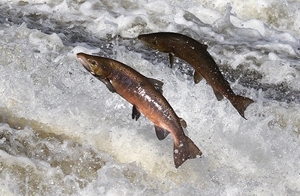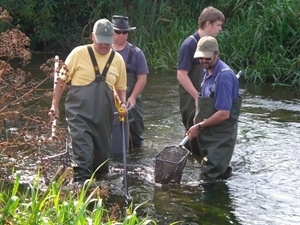Key points
- Wild Atlantic salmon populations have declined significantly across their range in the last 40 years.
- Scientists are concerned that the fish are encountering more challenges in the marine stage of their lifecycle than previously thought, which could be due to increased human activity and other coastal pressures.
- This study aimed to investigate the survival of seaward-migrating Atlantic salmon and brown trout smolts in four estuaries discharging to the English Channel.
- On average, over the two years of tracking, 79% of salmon smolts and 88% of trout smolts survived to migrate successfully through the four estuaries.
- Smolts in the River Frome estuary had a significantly lower survival rate than other estuaries.
- Estuaries are challenging environments for smolts, possibly inflicting large losses to wild stocks of salmon and trout, and solving this issue may be difficult due to the complexity of estuaries.
Background
 Wild Atlantic salmon populations have declined significantly across their range in the last 40 years. These declines have been linked to pressures such as habitat loss and fragmentation, and pollution in freshwater environments. In addition to these threats in rivers, scientists are concerned that salmon are encountering more challenges in the marine stage of their lifecycle.
Wild Atlantic salmon populations have declined significantly across their range in the last 40 years. These declines have been linked to pressures such as habitat loss and fragmentation, and pollution in freshwater environments. In addition to these threats in rivers, scientists are concerned that salmon are encountering more challenges in the marine stage of their lifecycle.
When young salmon and brown trout (collectively referred to as salmonids) migrate from freshwater to the ocean in the spring, they undergo changes that allow them to tolerate saltwater. These transformed salmonids, known as ‘smolts’, spend several months to years at sea before returning to their birthplace to reproduce.
Migrating smolts face various challenges both natural (such as changes in salinity and temperature, and predation) and human-caused (such as fishing, barriers to migration, and coastal development).
Understanding these challenges and their effects on salmonid survival is difficult due to the complex life cycle of salmon and the large number of potentially influential environmental variables. Little is known about how well they fare in specific environments like lower rivers, estuaries, or coastal areas, but scientists speculate that mortality during this phase could be high due to increased human activity and various environmental pressures.
What they did
Salmon and trout smolts were collected in spring 2018 and 2019 at two rivers in England, the River Frome and River Tamar, and two in France, the River Scorff and River Bresle.
Smolts were captured and fitted with small acoustic transmitters to enable scientists to track their journey through the estuary. The tagging was performed with great care and to best practice standards so that it did not significantly affect fish survival. The age, sex, size and body condition of each individual fish was recorded.
Environmental data including salinity, temperature and oxygen were collected from each estuary. Acoustic devices were deployed along the smolt migration path in each estuary from the tagging site to the exit, and fish were detected as they passed, giving scientists a measurement of their survival and migratory speed.
What they found
 Analysis of data from 474 tagged salmon and 360 trout smolts across the four estuaries revealed that overall salmon smolt survival (79%) was significantly lower than trout smolt survival (88%). In other words, up to 20 and 12% of salmon and trout smolts, respectively, likely died during their migration through the estuaries.
Analysis of data from 474 tagged salmon and 360 trout smolts across the four estuaries revealed that overall salmon smolt survival (79%) was significantly lower than trout smolt survival (88%). In other words, up to 20 and 12% of salmon and trout smolts, respectively, likely died during their migration through the estuaries.
The team found that smolt survival decreased with migration distance, and faster-migrating smolts were more likely to survive.
They also found that smolts in the River Frome estuary had a significantly lower survival rate than other estuaries.
What does this mean?
Migration speed had a positive effect on survival, perhaps because faster swimming might enable fish to move through dangerous areas quickly and avoid predators. Interestingly, the average swimming speed of trout was slower than salmon, so this speed relationship does not explain the higher survival of trout. However, because trout are usually larger and can accelerate faster than salmon, they may be better at avoiding predation.
There was no discernible effect on estuarine survival of smolt body condition, age, and sex, or water salinity, temperature, and oxygen levels. We know from previous GWCT research that salmon smolts with longer body lengths survive better during their entire marine migration (i.e. not just their estuarine migration), but size did not seem to have an effect in this study. This might indicate that bigger size aids survival at a later stage; for example, the fish may be more able to endure poor feeding conditions at sea.
Smolt survival decreased with migration distance, broadly indicating that mortality was higher in fish that had further to swim. This could be because more hazards may be present over a longer distance, but this was not the case in this study – where the longest estuary studied (the Tamar) actually had a higher survival rate than the others.
The River Frome estuary had a lower total survival of both salmon (51%) and trout (73%) smolts compared with the three other estuaries (88% for salmon and 96% for trout). This might be because the Frome has a ‘balloon’ shaped estuary, offering a multitude of possible migration routes and causing fish to range widely, increasing their migration distance and time spent in this risky environment.
Estuaries represent only a small portion of the seaward migration, but this study found a significant percentage of fish do not survive their passage through them. On their return, fish will cross estuaries again, which could also potentially account for additional losses as they make their way back into their natal rivers.
Solving this issue may be difficult due to the complexity of estuarine habitats and the number of varying factors, both in terms of environmental and body characteristics. Further research into the routes fish take through estuaries will be necessary to find the best way of monitoring and managing wild salmonids in these challenging environments.
Read the original paper
Artero C, Gregory SD, Beaumont WA, Josset Q and others (2023) Survival of Atlantic salmon and sea trout smolts in transitional waters. Mar Ecol Prog Ser 709:91-108.